The village of Oak Park, on Chicago’s western border, makes
an interesting case study in zoning, transit, and density variables regarding
walkable urbanism. The population is
roughly 50,000 people and is 5 square miles, yielding a population density of
10,000 people per square mile. This
makes it more densely populated than Los Angeles (7,500 people per square mile) or Atlanta (4,000 people per square mile), and only slightly
less than Chicago (12,000 people per square mile). The average walkable score is 72, though as we will see the score for some areas is even higher.
Oak Park has a variety of transit options, most of which are
geared towards commuting to downtown Chicago.
There are two CTA lines of the L – the green and the blue lines – which
run through Oak Park to downtown Chicago.
There is also a Metra line with a stop in Oak Park and again a terminus
in downtown Chicago. Finally, the
Eisenhower Expressway runs through Oak Park towards downtown. All three of these transit options allow
commuters to travel from Oak Park to downtown Chicago. The green line has 3 stops in Oak Park: Lake and Harlem, Lake and Oak Park, and Lake
and Ridgeland. The blue line has 2 stops
in Oak Park: Oak Park Avenue and
Austin. The Metra stop is on Lake and
Harlem. There are two on/off ramps to
the Eisenhower Expressway: Harlem and
Austin, which are the east and west borders of the village.
The CTA also operates bus lines that run through Oak Park, and there is a Pace bus line that runs through Oak Park. Neither of the bus lines run directly from Oak Park to downtown Chicago.
The CTA also operates bus lines that run through Oak Park, and there is a Pace bus line that runs through Oak Park. Neither of the bus lines run directly from Oak Park to downtown Chicago.
The borders are drawn in black and run along Austin Blvd on the east (borders Chicago), North Ave on the north, Harlem Ave on the west, and Roosevelt Rd on the south. The green and blue lines are shaded purple and the Metra is shaded green. The Metra and the green line share the same tracks through Oak Park.
Oak Park is therefore intrinsically walkable with a robust
population density and a many excellent transit options. This offers an opportunity to carefully
survey the look and feel of density, transit incentives, and zoning
issues. We can also compare the walk score of this neighborhood to a careful survey of the intersection. This inaugural survey will focus on the intersection of Lake Street and Euclid Avenue.
This intersection provides a fascinating case study as 4
different examples of zoning and design are represented on each of the 4
corners of this intersection. First is a
single use residential building consisting of condominiums. As you can see it is built with no surface
parking allotments; residents are provided underground parking. The building is positioned right up against
the street with only a few feet between the building wall and the sidewalk. The
condominium is 4 stories.
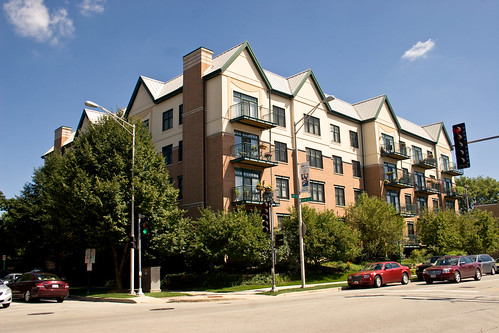
The northeast corner of Lake and Euclid
Second is another single use building, also residential, consisting of apartments. Again there is no surface parking; residents again make use of underground parking. The apartment building is also 4 stories. Neither of these buildings are very tall. The architecture of this building should be noted for the Frank Lloyd Wright influences; Frank Lloyd Wright’s home and studio along with many early examples of his prairie style are found in Oak Park. Thus rather than being cliché the style fits the ethos of Oak Park.
Second is another single use building, also residential, consisting of apartments. Again there is no surface parking; residents again make use of underground parking. The apartment building is also 4 stories. Neither of these buildings are very tall. The architecture of this building should be noted for the Frank Lloyd Wright influences; Frank Lloyd Wright’s home and studio along with many early examples of his prairie style are found in Oak Park. Thus rather than being cliché the style fits the ethos of Oak Park.
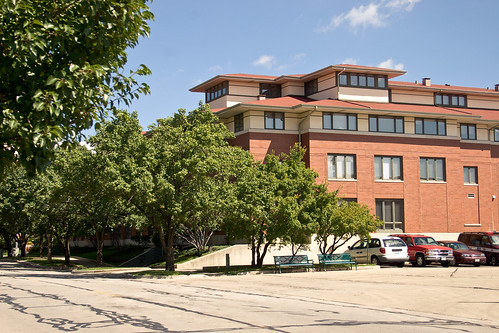
Facing Euclid, camera pointed north

The southwest part of the building facing Euclid
The third corner is interesting in that it is mixed use; the only mixed use building on this intersection. The ground floor is composed of retail space and the remaining 3 floors are - I believe - residential space. Again this is a 4 story building, and again it has no surface parking. It does not, however, have underground parking. The ground floor businesses are a Starbucks coffee shop, a Jimmy John’s sandwich shop, a Great Clips hair salon, and Frame Up picture frame store. I believe the final store front space is vacant and for lease.
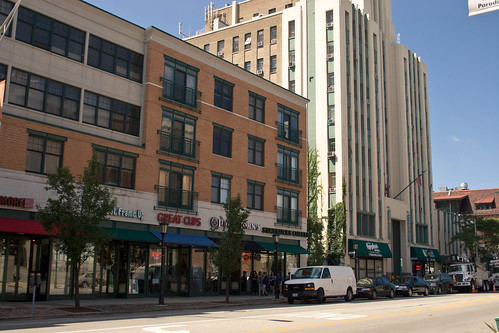
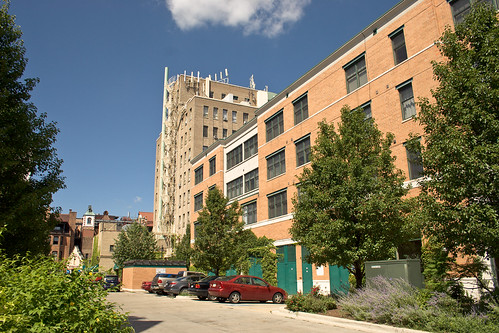
The alley behind the retail space with limited employee parking and loading zone space
A caveat: mixed use is a rather vague term but for the purposes of this blog mixed use will refer to parcel which allocate retail space mixed with non-retail space. The non-retail space does not necessarily mean residential. For example, a building might have retail floorspace on the ground level with a corporate office on the upper floors. And indeed the Art Deco building to the west has a pharmacy on the ground floor and was the former home of the Tribune’s Oak Park Leaves publication offices on the upper floors.
The final corner of Lake and Euclid has a hot dog
restaurant. One of hundreds of hot dog
places in Chicagoland, this particular hot dog restaurant is a single use
single story building and has surface parking and a drive through window. The dogs are ok but I prefer Portillos.
Proceeding north from this intersection is a block of single
family residences. These single family
residences, which are typical of Oak Park, deserve a full account of their
own. Proceeding south from this
intersection is another single use building, this time a series of 3 story
townhomes. Again there is no surface
parking, this time having the parking garage embedded in the first floor of the
building. There is also a fire
department building south of Lake and Euclid across the street from the
townhomes. Euclid is cut short by the
embankment which carries the green line train, the Metra, and a freight rail line. The green line has a stop a block away on Oak
Park Avenue.
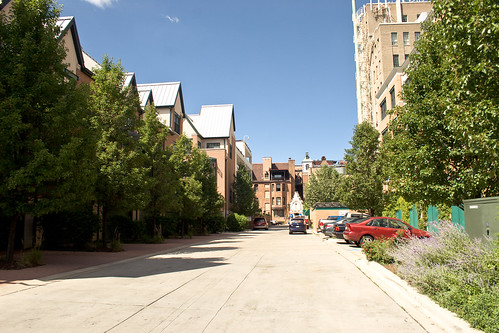
The alley again, this time facing the townhomes
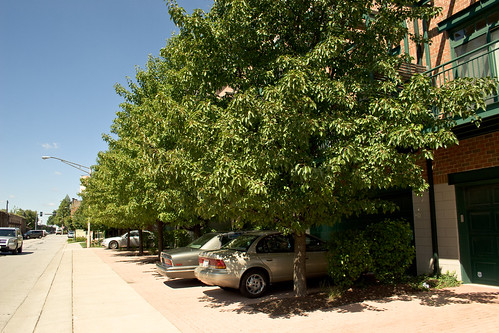
The south side of the townhomes facing the train tracks

Ground level garage parking
There are a few instructive elements in this compact space. First is the attainment of density without great building height. Simply removing surface parking has allowed 3 and 4 story buildings to produce dense neighborhoods. Second, that these dense areas can cohabitate with the automobile. By putting parking underneath the building on the ground floor or in the basement the residents can still own a car and enjoy all the benefits of having a car in the transit calculus. Indeed such a parking arrangement provides two ancillary benefits; security from petty larceny and protection from winter cold starts, the most wearing element to a car's longevity. Third, that mixed use can do more to make a small neighborhood walkable than density alone. By having that one building mixed use it created more retail storefronts (4 with 1 more possible) than the single use retail space on the opposite corner, having just one store. This does more to make this intersection walkable than if it were one single use retail plot and three 10 story apartment buildings. Finally, it demonstrates the limits of dense, mixed use neighborhoods. This intersection's retail space might not be useful to a resident that doesn't like eating hotdogs or sandwiches or want haircuts and picture frames. What you are walking to is a salient concern. Luckily for residents this neighborhood has many options; the possibility of walking further down Lake Street where retail spaces continue on, taking the green line train to a shopping destination, driving, or taking a bus. However, as we have seen before sometimes the incentives point towards driving.
Overall the walk score for this intersection is an outstanding 95. I hope that you found this microstudy to be an interesting
case study for some of the issues involving urban living, especially density,
walkability, and cars.


No comments:
Post a Comment